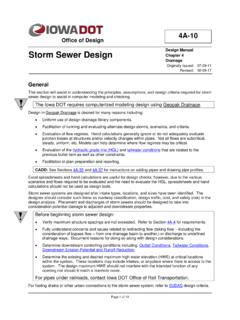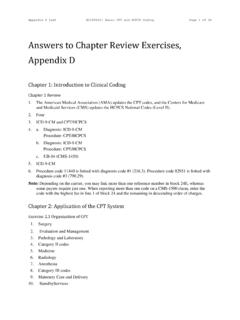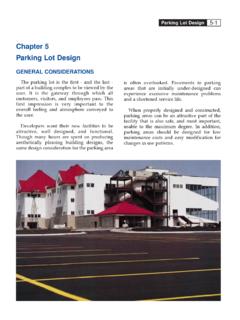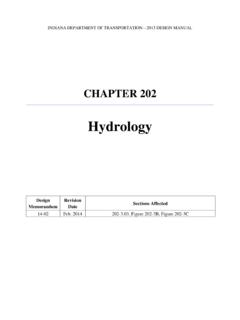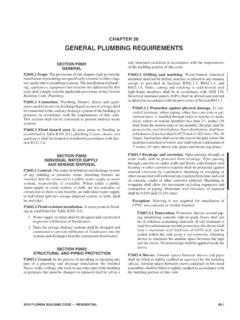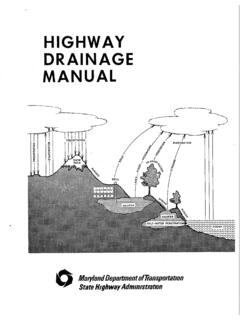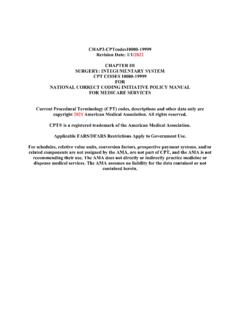Transcription of Drainage and Stormwater Management
1 DelDOT Road Design Manual July 2008 Highway Drainage and Stormwater Management 6-1 chapter Six Drainage and Stormwater Management INTRODUCTION Adequate Drainage is essential in the design of highways since it affects the highway s serviceability and usable life, including the pavement s structural strength. If ponding on the traveled way occurs, hydroplaning becomes an important safety concern. Drainage design involves providing facilities that collect, transport and remove Stormwater from the highway. The design must also consider the Stormwater reaching the roadway embankment through natural stream flow or manmade ditches. This chapter deals with Drainage policies, procedures and guidance to be followed in achieving cost-effective design and construction within DelDOT's Highway System.
2 The information contained herein is compiled from various federal and national publications, textbooks, and Drainage manuals. The information provided is of a general nature with the inclusion of methods, criteria and references specifically applicable to DelDOT projects. Source documents are listed in the introduction to each section. It is presumed that the designer is familiar with the basic theory and methods of analysis and design in both hydrology and hydraulics. The information provided herein will have to be supplemented with hard copies or on-line access to the referenced documents. The regulatory environment related to Drainage design is ever changing and continues to grow in complexity.
3 Engineers responsible for the planning and design of Drainage facilities must be familiar with Federal, state, county and local regulations, laws, and ordinances that may impact the design of storm drain systems. Many federal laws have implications that affect Drainage design. These include laws concerning: Flood insurance and construction in flood hazard areas, Navigation and construction in navigable waters, Water pollution control, Environmental protection, Protection of fish and wildlife, and Coastal zone Management . Federal agencies formulate and promulgate rules and regulations to implement these laws. Highway hydraulic engineers should keep informed regarding proposed and final regulations. Some of the more significant federal laws affecting highway Drainage are: The Department of Transportation Act established the Department of Transportation and sets forth its powers, duties, and responsibilities to establish, coordinate, and maintain an effective administration of the transportation programs of the Federal Government.
4 Federal-Aid Highway Acts provide for the administration of the Federal-Aid Highway Program. Proposed Federal-aid projects must meet existing and probable future traffic needs and conditions in a manner conducive to safety, durability, and economy of maintenance, and must be DelDOT Road Design Manual 6-2 Highway Drainage and Stormwater Management July 2008 designed and constructed according to standards best suited to accomplish this and to conform to the needs of each locality. Federal-Aid Highway Act of 1970 provides for the establishment of general guidelines to ensure that possible adverse economic, social and environmental effects relating to any proposed Federal-aid project have been fully considered in developing the project.
5 In compliance with the Act, the Federal Highway Administration (FHWA) issued process guidelines for the development of environmental action plans as contained in the Federal-Aid Highway Program Manual (FHPM) and in 23 CFR 795 et seq. Federal-Aid Highway Act of 1966 amended by the Act of 1970 requires the issuance of guidelines for minimizing possible soil erosion from highway construction. In compliance with these requirements, the FHWA issued guidelines that are applicable to all Federal-aid highway projects. These guidelines are included in the FHPM. Regulatory material is found in 23 CFR All Federal-aid projects shall conform to FHWA guidelines.
6 FHWA policy includes the following: FHWA Policy 23 CFR635 Subpart D General Material Requirements FHWA Policy 23 CFR650 Subpart A Location and Hydraulic Design of Encroachments on Floodplains establishes policy affecting any project that includes an encroachment on a base floodplain. FHWA Policy 23 CFR650 Subpart C National Bridge Inspection Standards defines the national standards for the proper safety inspection and evaluation of all highway bridges including the evaluation of bridges for scour susceptibility in accordance with the guidance in FHWA Technical Advisory FHWA Policy 23 CFR650 Subpart H Navigational Clearances for Bridges requires coordination with the United States Coast Guard (USCG) and United States Army Corps of Engineers (USACE) in providing adequate vertical and horizontal clearance for navigation on navigable waterways.
7 Other federal laws affecting hydraulic tasks, analyses, design, or construction include those formulated under the following legislative acts: The Coastal Zone Management Act of 1972 The Federal Water Pollution Control Act (Clean Water Act) The Fish and Wildlife Act of 1956 The Fish and Wildlife Coordination Act The Flood Disaster Protection Act of 1973 The National Environmental Policy Act (NEPA) of 1969 The Rivers and Harbors Act (1899) The Safe Drinking Water Act of 1974 Water Quality Act of 1987 Wild and Scenic Rivers Act DESIGN RESPONSIBILITIES Responsibilities for Drainage design are divided between the Bridge Design and Project Development sections based primarily on the size of the Drainage basin. Bridge Design is responsible for all watersheds over 300 ac and locations where the design discharge capacity opening(s) exceeds 20 ft2.
8 Project Development is responsible for: All locations requiring pipe culverts not exceeding 20 ft2 of waterway opening; Closed Drainage systems involving storm drains; Roadside Drainage including swales and ditches; Erosion and sediment control for transportation projects; DelDOT Road Design Manual July 2008 Highway Drainage and Stormwater Management 6-3 Stormwater quantity and quality Management . The section responsible for design of the Drainage structure shall also design the related stream bank stabilization and erosion control. The scope of this chapter is limited to the Drainage design responsibilities of the Project Development Section. Refer to chapter Three of the Bridge Design Manual for information on Drainage design for structures.
9 Structural designs are coordinated through the Bridge Design Section. DESIGN CRITERIA The Department has established basic design criteria for design storm frequency depending upon roadway type, and the design of open channel flow, pipe flow, pavement Drainage , and storm drains (closed Drainage systems). These criteria are summarized in Figures 6-1 through 6-3. DESIGN PROCEDURES The goal of Drainage design is to economically design systems that limit the exposure of adjoining upstream and downstream properties, the newly constructed roadway and the traveling public to an acceptable flood risk during high flows. Attachment B has several example problems that illustrate the design procedure for the most commonly used Drainage facilities used on a roadway project.
10 AASHTO s Model Drainage Manual is one of the best resources for preparing a project s Drainage design. In addition, DelDOT has an Internet Web Site ( ) that has additional Drainage references. Below is a brief description of Drainage design steps normally followed when designing roadway facilities. Each of these is expanded in sections referenced in the steps. Step 1. Data collection (Section ) includes: a. Establish agency requirements and define design criteria and parameters. b. Access the applicable online Drainage design resources (hard copies, if necessary), other design references, environmental controls, Drainage criteria, etc. c. Prepare a Drainage area map using USGS maps, topographic maps and aerial photography.

